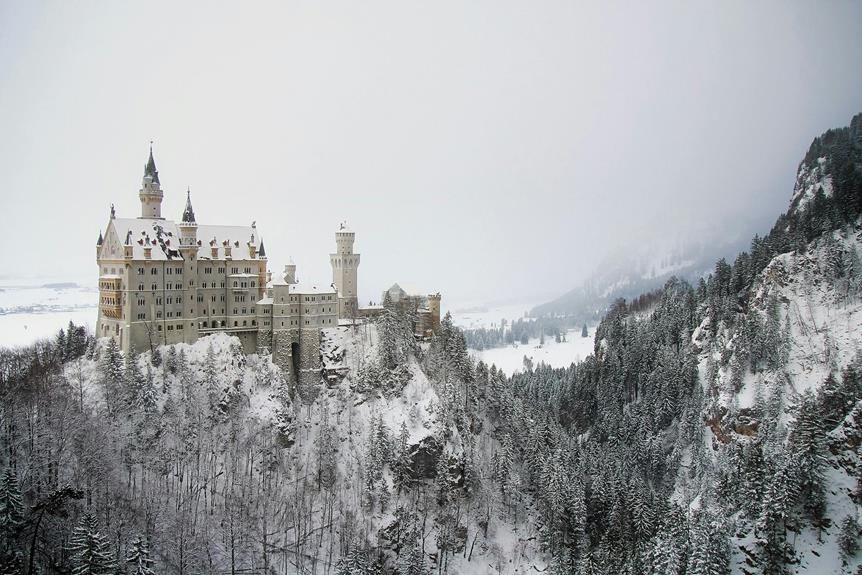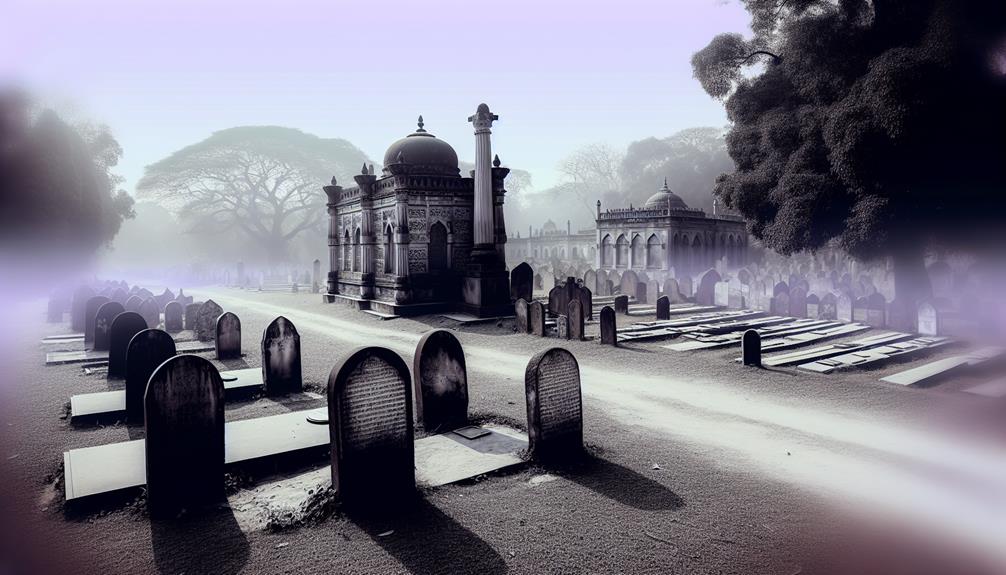Steeped in history and shrouded in mystique, St. Louis Cemetery in New Orleans, USA, beckons visitors to explore its hallowed grounds. With a tapestry of cultural influences and a wealth of architectural treasures, this cemetery serves as a living proof to the city's past. From the enigmatic tombs of famous figures to the eerie voodoo connections that linger in the air, St. Louis Cemetery offers a glimpse into a world where the line between the living and the dead blurs. As visitors wander through its labyrinthine paths, they are bound to uncover stories that resonate with both the heart and the soul.
Key Takeaways
- Diverse burial practices and architectural styles influenced by European customs.
- Notable tombs like Nicolas Cage's pyramid and Glapion family mausoleum.
- Rich voodoo connections and mystical legends.
- Preservation efforts balance modern methods with historical significance.
- Offers group and private tours ranging from $15 to $30 per person.
History of St. Louis Cemetery
The origins of St. Louis Cemetery in the United States can be traced back to the early 19th century when it was established as a final resting place for prominent local figures and families. This historic cemetery, located in New Orleans, Louisiana, reflects a blend of diverse burial practices and architectural styles prevalent during that period.
During the early 1800s, traditional European burial customs heavily influenced the design and layout of cemeteries in the United States. St. Louis Cemetery embraced this trend by incorporating above-ground tombs and mausoleums, a practice that was not only aesthetically pleasing but also practical due to the high water table in the region. The architectural styles of the tombs vary, showcasing a mix of Greek Revival, Gothic Revival, and Egyptian Revival influences, reflecting the eclectic tastes of the era's elite families.
Moreover, the cemetery's layout and design were meticulously planned to accommodate the burial practices of different cultural and religious groups residing in New Orleans. From elaborate family tombs to simple grave markers, St. Louis Cemetery served as a final resting place that honored the diverse backgrounds and beliefs of the deceased.
Notable Tombs and Mausoleums
Elegance and grandeur define the collection of notable tombs and mausoleums within St. Louis Cemetery, showcasing a rich tapestry of architectural styles and historical significance. As tourist attractions, these structures stand as architectural marvels, drawing visitors from around the world to admire their beauty and learn about the stories they hold.
Among the most notable tombs is the striking white pyramid tomb of Nicolas Cage, a renowned actor. This unique structure stands out against the backdrop of more traditional tombs, capturing the attention of all who visit. Another prominent tomb is the Glapion family mausoleum, a beautiful example of Gothic Revival architecture, adorned with intricate details and sculptures that reflect the family's wealth and status.
Visitors to St. Louis Cemetery also marvel at the striking beauty of the Italian Society Tomb, a masterpiece of Italianate design that exudes elegance and sophistication. The tomb's intricate carvings and ornate details make it a standout attraction within the cemetery, showcasing the craftsmanship and artistry of the time.
Each of these notable tombs and mausoleums not only serves as a tribute to the individuals and families interred within but also provides a glimpse into the rich history and diverse architectural styles that make St. Louis Cemetery a must-visit destination for history enthusiasts and architecture lovers alike.
Voodoo Connections and Legends
With a history deeply intertwined with the mystical world, St. Louis Cemetery in the USA boasts a rich tapestry of voodoo connections and legends that intrigue visitors and historians alike. The cemetery, located in New Orleans, is renowned for its association with voodoo rituals and supernatural occurrences.
Voodoo, a spiritual belief with African roots, has a significant presence in St. Louis Cemetery. Many visitors are drawn to the cemetery due to its reputation as a site where voodoo rituals have taken place over the years. The cemetery's history is steeped in the mysticism of voodoo, adding an air of intrigue and mystery to the already haunting atmosphere.
Legends surrounding St. Louis Cemetery further contribute to its mystique. Stories of spirits wandering among the tombs and mausoleums, believed to be connected to voodoo practices, have been passed down through generations. These tales add to the allure of the cemetery, enticing those interested in the supernatural and paranormal.
Visitors to St. Louis Cemetery often report feeling a sense of unease or a presence beyond the physical domain. The combination of voodoo connections and legendary tales creates an atmosphere unlike any other, making St. Louis Cemetery a must-visit destination for those intrigued by the mystical and unknown.
Preservation Efforts and Challenges
Integrating modern preservation methods while respecting the historical significance of St. Louis Cemetery presents a complex challenge requiring a delicate balance between conservation and accessibility. Preservation efforts at St. Louis Cemetery have been pivotal in ensuring the longevity of this historic site. Various restoration projects have been undertaken to address issues like weathering, vandalism, and structural decay. However, funding for these projects remains a constant challenge. Securing adequate financial resources to support ongoing preservation work is essential to safeguarding the cemetery's cultural heritage for future generations.
Community engagement plays an important role in the preservation of St. Louis Cemetery. Volunteerism has been instrumental in supplementing professional restoration efforts. Local residents, historical societies, and preservation organizations have actively participated in clean-up initiatives, fundraising events, and educational programs aimed at raising awareness about the cemetery's significance. This grassroots involvement not only fosters a sense of ownership and pride within the community but also enhances the overall preservation outcomes.
Despite these commendable efforts, preserving St. Louis Cemetery continues to present significant challenges. Balancing the need for conservation with the demand for accessibility requires careful planning and coordination. Striking the right equilibrium between protecting the site's historical integrity and making it available to visitors is an ongoing endeavor that necessitates innovative solutions and sustained commitment from all stakeholders involved in the preservation process.
Famous Burials and Their Stories
Renowned for its historical significance, St. Louis Cemetery in the USA houses the final resting places of notable figures whose stories offer a glimpse into the diverse tapestry of American history. Among the graveyard tales and mysterious legends, the cemetery is home to famous residents with intriguing stories that have captivated visitors for generations.
One of the most famous burials in St. Louis Cemetery is that of Marie Laveau, the renowned Voodoo priestess. Her grave attracts numerous visitors seeking blessings or leaving offerings in line with Voodoo traditions. Visitors often report experiencing a sense of mystique and wonder near her grave, adding to the cemetery's aura of mystery.
Another notable resident is Homer Plessy, whose act of civil disobedience led to the landmark Supreme Court case Plessy v. Ferguson, solidifying racial segregation laws in the United States. His grave serves as a reminder of the ongoing struggle for civil rights and equality.
Additionally, the tomb of Paul Morphy, a chess prodigy from the 19th century, stands as a tribute to his genius and strategic prowess. His burial site is a pilgrimage spot for chess enthusiasts worldwide, drawn to the legacy of one of the greatest chess players in history.
These famous burials and their stories intertwine to create a rich tapestry of American history within the grounds of St. Louis Cemetery, showcasing the diverse and complex narratives that have shaped the nation.
Guided Tours and Visitor Information
Nestled within the historical grounds of St. Louis Cemetery in the USA, guided tours provide visitors with thorough insights into the cemetery's notable residents and unparalleled historical significance.
Key Visitor Information:
- Tour Schedules and Prices: Guided tours of St. Louis Cemetery typically run daily, with varying schedules based on the season. Visitors can choose from different tour options, such as group tours or private tours, each offering a holistic perspective on the cemetery's rich history. Prices usually range from $15 to $30 per person, depending on the tour's duration and inclusions.
- Visitor Etiquette and Rules: To guarantee a respectful and enriching experience for all, visitors are expected to adhere to specific etiquette guidelines and rules. These may include maintaining a quiet and reverent demeanor, refraining from touching or defacing any graves or monuments, and following the instructions of the tour guide at all times. Additionally, photography regulations may apply, so visitors should inquire about any restrictions before capturing moments within the cemetery.
- Additional Services: In addition to guided tours, St. Louis Cemetery may offer supplementary services such as educational workshops, special events, or self-guided tour maps for independent exploration. These offerings can enhance visitors' understanding of the cemetery's cultural and historical significance, providing a thorough experience beyond the guided tours.
- Accessibility Information: Visitors with mobility concerns should inquire about the cemetery's accessibility features, such as wheelchair-friendly routes or accommodations for individuals with disabilities. Ensuring inclusivity and comfort for all visitors is a priority at St. Louis Cemetery, allowing everyone to appreciate its heritage and beauty.
Cultural Significance and Impact
The cultural significance and impact of St. Louis Cemetery in the USA can be thoroughly understood through its profound historical narratives and enduring influence on the community. Established in the late 18th century, St. Louis Cemetery stands as a testament to the diverse cultural heritage of New Orleans, encompassing a blend of Catholic, African, and French traditions. This unique fusion has not only shaped the physical landscape of the cemetery but has also contributed to the rich tapestry of traditions that define the local community.
One of the most notable impacts of St. Louis Cemetery is its influence on tourism in New Orleans. As one of the oldest and most famous cemeteries in the city, St. Louis Cemetery attracts visitors from around the world who come to explore its historic tombs and learn about the prominent figures buried within its walls. The cemetery's architectural beauty and cultural significance have made it a must-see destination for history enthusiasts and tourists alike, contributing significantly to the local economy.
Furthermore, St. Louis Cemetery plays a vital role in preserving and perpetuating community traditions. The annual All Saints' Day celebrations and other religious ceremonies held at the cemetery serve as a reminder of the deep-rooted customs and beliefs that have been passed down through generations. By honoring these traditions, St. Louis Cemetery continues to be a symbol of resilience and cultural pride for the people of New Orleans.
Frequently Asked Questions
Can Visitors Spend the Night in St. Louis Cemetery?
Visitors seeking overnight accommodations may find unique experiences in various locations. Staying at historical sites can offer a deeper connection to the past and a chance to immerse oneself in a spooky atmosphere.
However, it is important to remember that not all places allow overnight stays, so it is essential to research and plan accordingly. This type of stay can provide an unparalleled opportunity for those interested in history and seeking a memorable adventure.
Are There Any Hidden Passageways or Secret Rooms in the Cemetery?
Exploring hidden tunnels and crypts can be an intriguing experience for those curious about secret passageways.
While many cemeteries are known for their historical significance and architectural beauty, the presence of hidden rooms adds an element of mystery.
Crypt exploration offers a glimpse into the intricate design and layout of burial sites, highlighting the craftsmanship and attention to detail that went into creating these underground spaces.
Do Any Paranormal Investigation Groups Visit the Cemetery Regularly?
Ghost hunters and paranormal investigation groups frequently explore locations known for reported paranormal activity and encounters. These groups utilize various equipment and techniques to document any potential supernatural phenomena.
With a focus on gathering evidence and conducting thorough investigations, these individuals aim to shed light on the unexplained and provide a deeper understanding of the possible presence of ghosts or spirits in these locations.
Are There Any Restrictions on Photography or Filming in the Cemetery?
In general, photography restrictions in cemeteries are commonly in place to protect the privacy and respect the solemnity of the resting place. Filming rules often align with these restrictions, aiming to maintain the tranquility and integrity of the site.
These regulations typically prohibit commercial photography or filming without prior authorization, ensuring that the environment remains undisturbed and the memories of those interred are honored appropriately.
Are There Any Special Events or Ceremonies Held at St. Louis Cemetery Throughout the Year?
Annual celebrations and cultural events are an integral part of many historic sites and landmarks around the world. These events often include historical tours, cemetery festivals, and other special ceremonies that showcase the rich heritage and traditions of the location.
Such gatherings not only educate visitors about the past but also provide an opportunity for communities to come together and celebrate their shared history in a meaningful way.
Conclusion
To sum up, St. Louis Cemetery in New Orleans is a mesmerizing site that holds a wealth of historical and cultural significance. With over 100,000 interments in its compact space, the cemetery serves as a powerful reminder of the city's rich heritage and diverse community.
The unique blend of burial practices, architectural styles, and mystical legends make St. Louis Cemetery a truly enchanting destination for those seeking to explore the vibrant tapestry of New Orleans' history.


